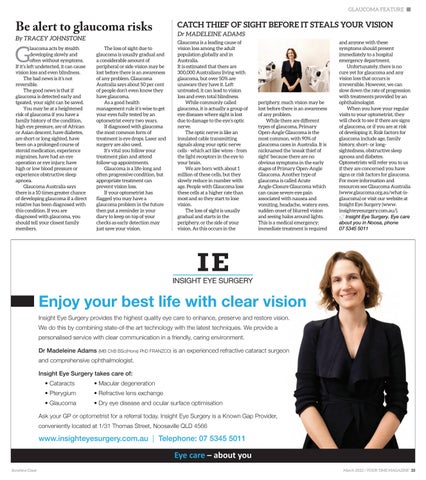GLAUCOMA FEATURE
Be alert to glaucoma risks By TRACEY JOHNSTONE
G
laucoma acts by stealth developing slowly and often without symptoms. If it’s left undetected, it can cause vision loss and even blindness. The bad news is it’s not reversible. The good news is that if glaucoma is detected early and tgeated, your sight can be saved. You may be at a heightened risk of glaucoma if you have a family history of the condition, high eye pressure, are of African or Asian descent, have diabetes, are short or long sighted, have been on a prolonged course of steroid medication, experience migraines, have had an eye operation or eye injury, have high or low blood pressure or experience obstructive sleep apnoea. Glaucoma Australia says there is a 10 times greater chance of developing glaucoma if a direct relative has been diagnosed with this condition. If you are diagnosed with glaucoma, you should tell your closest family members.
The loss of sight due to glaucoma is usually gradual and a considerable amount of peripheral or side vision may be lost before there is an awareness of any problem. Glaucoma Australia says about 50 per cent of people don’t even know they have glaucoma. As a good health management rule it’s wise to get your eyes fully tested by an optometrist every two years. If diagnosed with glaucoma the most common form of treatment is eye drops. Laser and surgery are also used. It’s vital you follow your treatment plan and attend follow-up appointments. Glaucoma is a life-long and often progressive condition, but appropriate treatment can prevent vision loss. If your optometrist has flagged you may have a glaucoma problem in the future then put a reminder in your diary to keep on top of your checks as early detection may just save your vision.
CATCH THIEF OF SIGHT BEFORE IT STEALS YOUR VISION Dr MADELEINE ADAMS Glaucoma is a leading cause of vision loss among the adult population globally and in Australia. It is estimated that there are 300,000 Australians living with glaucoma, but over 50% are unaware they have it. Left untreated, it can lead to vision loss and even total blindness. While commonly called glaucoma, it is actually a group of eye diseases where sight is lost due to damage to the eye’s optic nerve. The optic nerve is like an insulated cable transmitting signals along your optic nerve cells - which act like wires - from the light receptors in the eye to your brain. We are born with about 1 million of these cells, but they slowly reduce in number with age. People with Glaucoma lose these cells at a higher rate than most and so they start to lose vision. The loss of sight is usually gradual and starts in the periphery, or the side of your vision. As this occurs in the
periphery, much vision may be lost before there is an awareness of any problem. While there are different types of glaucoma, Primary Open-Angle Glaucoma is the most common, with 90% of glaucoma cases in Australia. It is nicknamed the ‘sneak thief of sight’ because there are no obvious symptoms in the early stages of Primary Open-Angle Glaucoma. Another type of glaucoma is called Acute Angle-Closure Glaucoma which can cause severe eye pain associated with nausea and vomiting, headache, watery eyes, sudden onset of blurred vision and seeing halos around lights. This is a medical emergency; immediate treatment is required
and anyone with these symptoms should present immediately to a hospital emergency department. Unfortunately, there is no cure yet for glaucoma and any vision loss that occurs is irreversible. However, we can slow down the rate of progression with treatments provided by an ophthalmologist. When you have your regular visits to your optometrist, they will check to see if there are signs of glaucoma, or if you are at risk of developing it. Risk factors for glaucoma include age, family history, short- or longsightedness, obstructive sleep apnoea and diabetes. Optometrists will refer you to us if they are concerned you have signs or risk factors for glaucoma. For more information and resources see Glaucoma Australia (www.glaucoma.org.au/what-isglaucoma) or visit our website at Insight Eye Surgery (www. insighteyesurgery.com.au/). Insight Eye Surgery. Eye care about you in Noosa, phone 07 5345 5011
Enjoy your best life with clear vision Insight Eye Surgery provides the highest quality eye care to enhance, preserve and restore vision. We do this by combining state-of-the art technology with the latest techniques. We provide a personalised service with clear communication in a friendly, caring environment. Dr Madeleine Adams (MB ChB BSc(Hons) PhD FRANZCO) is an experienced refractive cataract surgeon and comprehensive ophthalmologist. Insight Eye Surgery takes care of: • Cataracts
• Macular degeneration
• Pterygium
• Refractive lens exchange
• Glaucoma
• Dry eye disease and ocular surface optimisation
Ask your GP or optometrist for a referral today. Insight Eye Surgery is a Known Gap Provider, conveniently located at 1/31 Thomas Street, Noosaville QLD 4566
www.insighteyesurgery.com.au | Telephone: 07 5345 5011
Sunshine Coast
33.indd 3
March 2022 / YOUR TIME MAGAZINE 33
2/03/2022 4:15:09 PM











